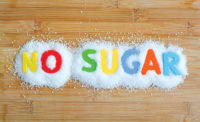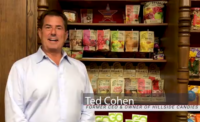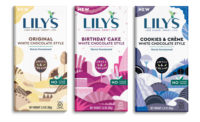As sugar-free sweeteners evolve, health concerns and better-tasting confections attract a wider variety of consumers to the sector.

As sugar-free sweeteners evolve, health concerns and better-tasting confections attract a wider variety of consumers to the sector.
By Crystal Lindell
Associate Editor
It’s a great time to be in the sugar-free confections business - at least according to Phil Lempert, the “SupermarketGuru.” And, that’s because consumers are having a change of heart for their first love, sugar.
“You don’t have to want to lose weight, you don’t have to be a diabetic, you don’t have to have a doc tell you use an artificial sweetener,” he explains. “The average American finally gets it that we consume too much sugar of all kinds.”
But don’t take Lempert’s word for it. The slew of new sugar-free products as well as the efforts to track down the better-than-the-last-one sugar substitute are proof that the segment will only continue to expand.
Maybe the best evidence that sugar-free has gone mainstream is that Wrigley, the leader in the gum and mints sector, debuted two classic flavors in a new sugar-free variety - Juicy Fruit and Doublemint.
“Dietary needs drive sugar-free purchases for some consumers, but ultimately, consumers now expect high-quality sugar-free offerings in gum and confections - and view them as better-for-you choices,” explains Jennifer Jackson Luth, senior manager – marketing communications, Wm. Wrigley Jr. Co.
Wrigley also has a number of other new sugar-free products or new sugar-free packaging concepts either in the works or already on store shelves, including: 5 RPM and Altoids Smalls as well as a new 18-count sugar-free Eclipse, Orbit White and Juicy Fruit pellet split-packs.
Jackson Luth says it’s not just sugar-free gum that appeals to consumers though.
“One example of a sugar-free product that enjoys a loyal consumer base is Life Savers,” she explains.
Of course, even with all the new ingredient technology advances, companies continue to seek out the elusive zero-calorie sweetener that really does taste exactly like sugar.
“The problem that we have is we [as consumers] have an unrealistic taste bud when it comes to sugar,” Lempert says. “We like everything so sweet.”
He believes there is hope though, and points to stevia, the sugar substitute approved for use in the United States in 2008.
“A lot of beverages or candies or all kinds of products have reformulated to take advantage of stevia,” Lempert explains. “‘It comes from a plant, it’s not a chemical. That’ probably been the most important development that we’ve seen [for sugar free].”
He says it actually tastes slightly sweeter than sugar, and it’s closer to the flavor of sugar than other options. However, Lempert did add that it’s still not quite the same.
Another sugar-free sweetener looking to make an impact on the U.S. market is xylitol.
“Xylitol’s been around for a long time - 25, 30 years,” Lempert says. “It really hasn’t taken off here the way it probably should have, or the way it has across the rest of the world.”
It may finally be catching on with U.S. companies and consumers though.
During the last year, the Hershey Co. introduce IceBreakersFrost sugar-mints in Wintercool and peppermint. Coated with a combination of xylitol, cooling and flavor crystals, the company says they deliver a “surprisingly powerful and enjoyable experience.”
“Ice Breakers Frost mints are designed for those who are looking for a strong mint, but don’t want to sacrifice taste. The mints feature the same great flavor of our core Ice Breakers mints, which is then frosted with a combination of xylitol, cooling and flavor crystals for a uniquely powerful taste and texture,” says Anna Lingeris, spokeswoman for Ice Breakers Frost mints and The Hershey Co. “The result is a satisfying and powerfully cool taste experience.”
And on a smaller scale, PÜR Gum also is marketing its use of xylitol, claiming it “kicks aspartame” - the other common sugar substitute.
“There’s no aftertaste. [The other] artificial sweetener would effectively coat your mouth,” says Jay Klein PÜR Gum’s president. “It’s unbelievable, parents, moms, diabetics, they can’t thank us enough for creating this product. There’s no difference in the flavor and the experience other than the ingredients are for the healthy aware.”
He says it’s especially good for diabetics.
“The xylitol doesn’t peak insulin levels,” Klein says. “When diabetics have [other] artificial sweeteners, their body feels like they’re actually consuming the real thing.”
As with all many trends, the question is whether sugar-free confections will ever outpace their sugar counterparts.
Jackson Luth says that’s already happened in the gum category, with sugar gum accounting for just 14% of gum sold. It’s unclear when that will level off, but she says it likely will never hit zero.
“While sugar-free products are an attractive offering to consumers, some will always prefer products that use real sugar for flavor,” Jackson Luth says.
Nevertheless, it’s clear that sugar-free has taken over that market. The same cannot be said about sugar-free chocolate though, which seems to be much harder to create. For example, Mars, the leading chocolate company, markets only sugar-free Dove chocolates.
Valor Chocolates in Spain - featured in this month’s manufacturer profile - is among those trying to push the market forward though. They make excellent, premium sugar-free chocolates, as in evidenced by their growing sales in that country.
Of course, the bean-to-bar manufacturer uses the same chocolate found in its regular line of products, which may attest to its true chocolate taste.
It’s surely evidence that the growth opportunity for sugar-free chocolates remains.




